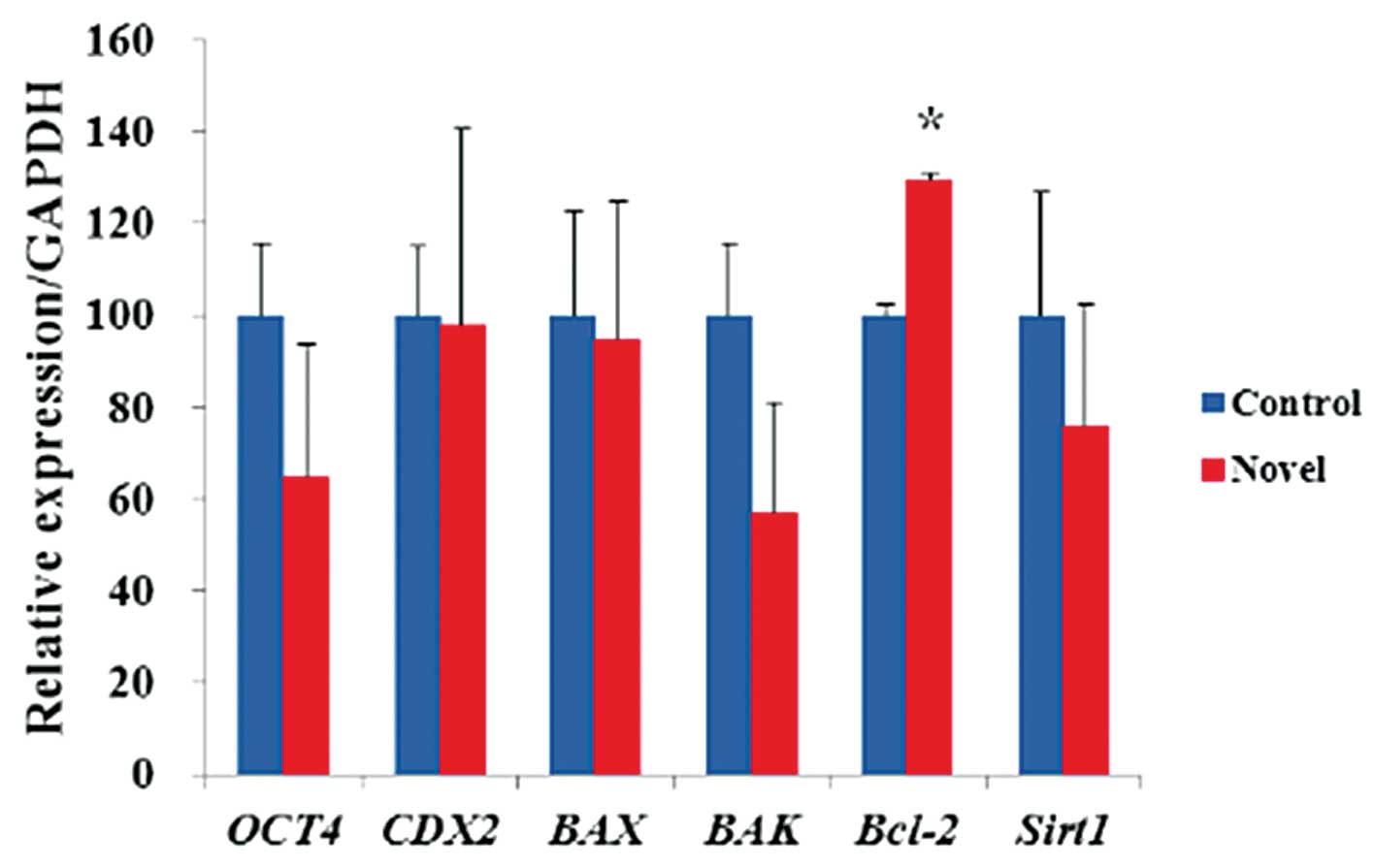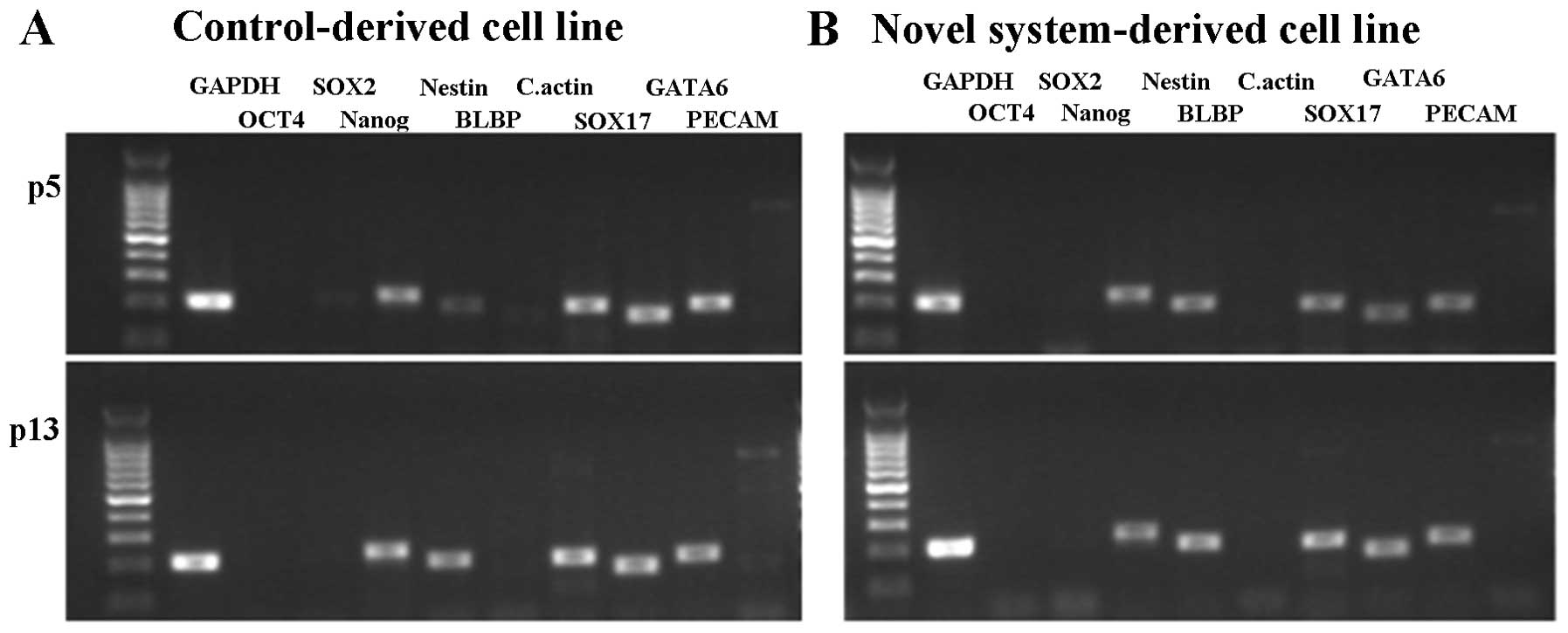|
1
|
Thomson JA, Itskovitz-Eldor J, Shapiro SS,
et al: Embryonic stem cell lines derived from human blastocysts.
Science. 282:1145–1147. 1998. View Article : Google Scholar : PubMed/NCBI
|
|
2
|
Evans MJ and Kaufman MH: Establishment in
culture of pluripotential cells from mouse embryos. Nature.
292:154–156. 1981. View
Article : Google Scholar : PubMed/NCBI
|
|
3
|
Handyside A, Hooper Ml, Kaufman MH and
Wilmut I: Towards the isolation of embryonal stem cell lines from
the sheep. Roux’s Arch Dev Biol. 196:185–190. 1987. View Article : Google Scholar
|
|
4
|
Doetschman T, Williams P and Maeda N:
Establishment of hamster blastocyst-derived embryonic stem (ES)
cells. Dev Biol. 127:224–227. 1988. View Article : Google Scholar : PubMed/NCBI
|
|
5
|
Sukoyan MA, Vatolin SY, Golubitsa AN,
Zhelezova AI, Semenova LA and Serov OL: Embryonic stem cells
derived from morulae, inner cell mass and blastocysts of mink:
comparisons of their pluripotencies. Mol Reprod Dev. 36:148–158.
1993. View Article : Google Scholar : PubMed/NCBI
|
|
6
|
Graves KH and Moreadith RW: Derivation and
characterization of putative pluripotential embryonic stem cells
from preimplantation rabbit embryos. Mol Reprod Dev. 36:424–433.
1993. View Article : Google Scholar : PubMed/NCBI
|
|
7
|
Talbot NC, Rexroad CE Jr, Pursel VG,
Powell AM and Nel ND: Culturing the epiblast cells of the pig
blastocyst. In Vitro Cell Dev Biol Anim. 29:543–554. 1993.
View Article : Google Scholar
|
|
8
|
First NL, Sims MM, Park SP and Kent-First
MJ: Systems for production of calves from cultured bovine embryonic
cells. Reprod Fertil Dev. 6:553–562. 1994. View Article : Google Scholar : PubMed/NCBI
|
|
9
|
Ouhibi N, Sullivan NF, English J, Colledge
WH, Evans MJ and Clarke NJ: Initial culture behaviour of rat
blastocysts on selected feeder cell lines. Mol Reprod Dev.
40:311–324. 1995. View Article : Google Scholar : PubMed/NCBI
|
|
10
|
Saito S, Ugai H, Sawai K, et al: Isolation
of embryonic stem-like cells from equine blastocysts and their
differentiation in vitro. FEBS Lett. 531:389–396. 2002. View Article : Google Scholar : PubMed/NCBI
|
|
11
|
Li P, Tong C, Mehrian-Shai R, et al:
Germline competent embryonic stem cells derived from rat
blastocysts. Cell. 135:1299–1310. 2008. View Article : Google Scholar : PubMed/NCBI
|
|
12
|
Buehr M, Meek S, Blair K, et al: Capture
of authentic embryonic stem cells from rat blastocysts. Cell.
135:1287–1298. 2008. View Article : Google Scholar : PubMed/NCBI
|
|
13
|
Lunney JK: Advances in swine biomedical
model genomics. Int J Biol Sci. 3:179–184. 2007. View Article : Google Scholar : PubMed/NCBI
|
|
14
|
Rui R, Qiu Y, Hu Y and Fan B:
Establishment of porcine transgenic embryonic germ cell lines
expressing enhanced green fluorescent protein. Theriogenology.
65:713–720. 2006. View Article : Google Scholar
|
|
15
|
Evans MJ, Notarianni E, Laurie S and Moor
RM: Derivation and preliminary characterization of pluripotent cell
lines from porcine and bovine blastocysts. Theriogenology.
33:125–128. 1990. View Article : Google Scholar
|
|
16
|
Vackova I, Ungrova A and Lopes F: Putative
embryonic stem cell lines from pig embryos. J Reprod Dev.
53:1137–1149. 2007. View Article : Google Scholar
|
|
17
|
Miyoshi K, Taguchi Y, Sendai Y, Hoshi H
and Sato E: Establishment of a porcine cell line from in
vitro-produced blastocysts and transfer of the cells into
enucleated oocytes. Biol Reprod. 62:1640–1646. 2000. View Article : Google Scholar : PubMed/NCBI
|
|
18
|
Procházka R, Petlach M, Nagyová E and
Němcová L: Effect of epidermal growth factor-like peptides on pig
cumulus cell expansion, oocyte maturation and acquisition of
developmental competence in vitro: comparison with gonadotropins.
Reproduction. 141:425–435. 2011. View Article : Google Scholar
|
|
19
|
Funahashi H, Cantley TC, Stumpf TT,
Terlouw SL and Day BN: In vitro development of in vitro-matured
porcine oocytes following chemical activation or in vitro
fertilization. Biol Reprod. 50:1072–1077. 1994. View Article : Google Scholar : PubMed/NCBI
|
|
20
|
Funahashi H, Kim NH, Stumpf TT, Cantley TC
and Day BN: Presence of organic osmolytes in maturation medium
enhances cytoplasmic maturation of porcine oocytes. Biol Reprod.
54:1412–1419. 1996. View Article : Google Scholar : PubMed/NCBI
|
|
21
|
Yoshida M, Ishigaki K, Nagai T, Chikyu M
and Pursel VG: Glutathione concentration during maturation and
after fertilization in pig oocytes: relevance to the ability of
oocytes to form male pronucleus. Biol Reprod. 49:89–94. 1993.
View Article : Google Scholar : PubMed/NCBI
|
|
22
|
Yoshioka K, Suzuki C and Onishi A: Defined
system for in vitro production of porcine embryos using a single
basic medium. J Reprod Dev. 54:208–213. 2008. View Article : Google Scholar : PubMed/NCBI
|
|
23
|
Nagashima H, Hiruma K, Saito H, et al:
Production of live piglets following cryopreservation of embryos
derived from in vitro-matured oocytes. Biol Reprod. 76:900–905.
2007. View Article : Google Scholar : PubMed/NCBI
|
|
24
|
Yoshioka K, Suzuki C, Tanaka A, Anas IM
and Iwamura S: Birth of piglets derived from porcine zygotes
cultured in a chemically defined medium. Biol Reprod. 66:112–119.
2002. View Article : Google Scholar
|
|
25
|
Dokras A, Sargent IL and Barlow DH: Human
blastocyst grading: an indicator of developmental potential? Hum
Reprod. 8:2119–2127. 1993.PubMed/NCBI
|
|
26
|
Richter KS, Harris DC, Daneshmand ST and
Shapiro BS: Quantitative grading of a human blastocyst: optimal
inner cell mass size and shape. Fertil Steril. 76:1157–1167. 2001.
View Article : Google Scholar : PubMed/NCBI
|
|
27
|
Kwak SS, Cheong SA, Jeon Y, et al: The
effects of resveratrol on porcine oocyte in vitro maturation and
subsequent embryonic development after parthenogenetic activation
and in vitro fertilization. Theriogenology. 78:86–101. 2012.
View Article : Google Scholar : PubMed/NCBI
|
|
28
|
Kwak SS, Jeung SH, Biswas D, Jeon YB and
Hyun SH: Effects of porcine granulocyte-macrophage
colony-stimulating factor on porcine in vitro-fertilized embryos.
Theriogenology. 77:1186–1197. 2012. View Article : Google Scholar
|
|
29
|
Yuh HS, Yu DH, Shin MJ, et al: The effects
of various antioxidants on the development of parthenogenetic
porcine embryos. In Vitro Cell Dev Biol Anim. 46:148–154. 2010.
View Article : Google Scholar
|
|
30
|
Zinkel S, Gross A and Yang E: BCL2 family
in DNA damage and cell cycle control. Cell Death Differ.
13:1351–1359. 2006. View Article : Google Scholar : PubMed/NCBI
|
|
31
|
Betts DH and King WA: Genetic regulation
of embryo death and senescence. Theriogenology. 55:171–191. 2001.
View Article : Google Scholar : PubMed/NCBI
|
|
32
|
Simon HU, Haj-Yehia A and Levi-Schaffer F:
Role of reactive oxygen species (ROS) in apoptosis induction.
Apoptosis. 5:415–418. 2000. View Article : Google Scholar
|
|
33
|
Stone JR and Yang S: Hydrogen peroxide: a
signaling messenger. Antiox Redox Signal. 8:243–270. 2006.
View Article : Google Scholar
|
|
34
|
Vackova I, Novakova Z, Krylov V, et al:
Analysis of marker expression in porcine cell lines derived from
blastocysts produced in vitro and in vivo. J Reprod Dev.
57:594–603. 2011. View Article : Google Scholar : PubMed/NCBI
|
|
35
|
Cheng EH, Chen W, Chang SY, et al:
Blastocoel volume is related to successful establishment of human
embryonic stem cell lines. Reprod Biomed Online. 17:436–444. 2008.
View Article : Google Scholar : PubMed/NCBI
|
|
36
|
Brevini T, Cillo F and Gandolfi F: 168
Establishment and molecular characterization of pig parthenogenetic
embryonic stem cells. Fertil Dev. 17:235. 2004. View Article : Google Scholar
|
|
37
|
Blomberg LA, Schreier LL and Talbot NC:
Expression analysis of pluripotency factors in the undifferentiated
porcine inner cell mass and epiblast during in vitro culture. Mol
Reprod Dev. 75:450–463. 2008. View Article : Google Scholar
|



















